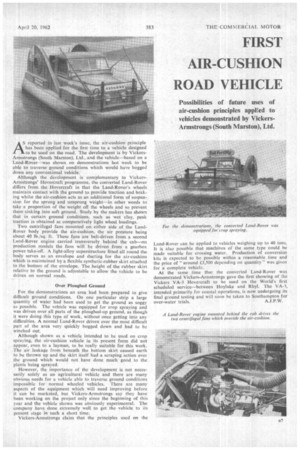FIRST AIR-CUSHION ROAD VEHICLE
Page 41

If you've noticed an error in this article please click here to report it so we can fix it.
Possibilities of future uses of air-cushion principles applied to vehicles demonstrated by VickersArmstrongs (South Marston), Ltd.
As reported in last week's issue, the air-cushion principle has been applied for the first time to a vehicle designed to be used on the road. The development is by VickersArmstrongs (South Marston), Ltd., and the vehicle—based on a Land-Rover—was shown on demonstrations last week to be able to traverse ground conditions which would have bogged dOwn any conventional vehicle.
Although the development is complementary to VickersArmstrongs' Hovercraft programme, the converted Land-Rover differs from the Hovercraft in that the Land-Rover's wheels maintain contact with the ground to provide traction and braking whilst the air-cushion acts as an additional form of suspension for the sprung and unsprung weight—in other words to take a proportion of the weight off the wheels and so prevent them sinking into soft ground. Study by the makers has shown that in certain ground conditions, such as wet clay, peak traction is obtained at comparatively light wheel loadings.
Two centrifugal fans mounted on either side of the LandRover body provide the air-cushion, the air pressure being about 40 lb./sq. ft. These fans are belt-driven from a second Land-Rover engine carried transversely behind the cab—on production models the fans will be driven from a gearbox power take-off. A light-alloy superstructure fitted all round the body serves as an envelope and ducting for the air-cushion which is maintained by a flexible synthetic-rubber skirt attached to the bottom of the envelope, The height of the rubber skirt relative to the ground is adjustable to allow the vehicle to be driven on normal roads.
Over Ploughed Ground For the demonstrations an area had been prepared to give difficult ground conditions. On one particular strip a large quantity of water had been used to get the ground as soggy as possible. The vehicle was equipped for crop spraying and was driven over all parts of the ploughed-up ground, as though it were doing this type of work, without once getting into any difficulties. A normal Land-Rover driven over the most difficult part of the area very quickly bogged down and had to be winched out.
Although shown as a vehicle intended to be used on crop spraying, the air-cushion vehicle in its present form did not appear, even to a layman, to be really suitable for this work. The air leakage from beneath the bottom skirt caused earth to be thrown up and the skirt itself had a scraping action over the ground which would not have done much good to the plants being sprayed.
However, the importance of the development is not necessarily solely as an agricultural vehicle and there are many obvious needs for a vehicle able to traverse ground conditions impossible for normal wheeled vehicles. There are many aspects of the equipment which will need improving before it can be marketed, but Vickers-Armstrongs say they have been working on the project only since the beginning of this year and the vehicle shown was obviously experimental. The company have done extremely well to get the vehicle to its present stage in such a short time.
Vickers-Armstrongs claim that the principles used on the
Land-Rover can be applied to vehicles weighing up to 40 tons. It is also possible that machines of the same type could be made suitable for crossing water. Production of conversion kits is expected to be possible within a reasonable time and the price of " around £3,500 depending on quantity " was given for a complete vehicle. At the same time that the converted Land-Rover was demonstrated Vickers-Armstrongs gave the first showing of the Vickers VA-3 Hovercraft to be used on the World's first scheduled service—between Iloylake and Rhyl. The VA-3, intended primarily for coastal operations, is now undergoing its final ground testing and wilt soon be taken to Southampton for over-water trials.
















































































































